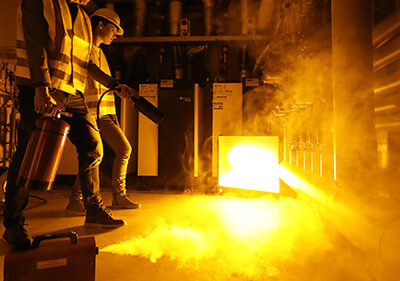Equipping employees to be prepared in case of a fire is not only extremely important, but is also required by law, according to OSHA. This includes maintaining fire extinguishers within the facilities, and training employees on how to use the extinguishers.
Using a Fire Extinguisher
Fire extinguishers work in one of three ways, by applying an extinguishing agent that:
- Cools the burning fuel
- Displaces or removes the available oxygen
- Stops the chemical reaction, so the fire can’t burn
When using a fire extinguisher, it’s helpful to remember the acronym PASS: Pull, Aim, Squeeze and Sweep. However if you have any doubts about your ability to fight the fire, evacuate the area immediately.
While discharging the extinguisher, back away and evacuate immediately if the extinguisher empties and the fire is not put out or if the fire progresses.
“If you are trying to fight a fire with an extinguisher, the most important thing to remember is to always position yourself with an exit or a means of escape at your back before you attempt to use an extinguisher,” said Nick Daniels, Extinguisher Manager at Ryan Fireprotection.
Assessing the Situation
Before using a fire extinguisher, it is important to consider the risk to your safety. You should never fight the fire if there isn’t adequate and appropriate equipment for the situation, if you could inhale toxic smoke or if your instincts tell you not to.
Some other key questions to consider include:
- How big is the fire?
- If the fire involves flammable solvents, is spread more than 60 square feet, is partially hidden behind a wall or ceiling, or cannot be reached from a standing position, it is too big to fight with a portable extinguisher.
- Is the air safe to breathe?
- Some materials, such as the nylon in carpeting or foam padding in a sofa, can produce hazardous and toxic gases, which can be fatal even in small amounts. If there is not any respiratory protection or it is not a well-ventilated area, it is not recommended to fight this fire.
- Is the environment getting too hot or too smoky?
- If the heat can be felt on exposed skin within 10-15 feet of the fire, or one is crawling on the floor due to lack of visibility, it is too smoky to fight with a portable extinguisher.
- Is there a safe evacuation path?
- If the fire is not contained or blocking the evacuation path, do not stay and fight this fire.
- If the fire is not contained or blocking the evacuation path, do not stay and fight this fire.
For a refresher, read Part 1: Sources and Classes of Fire or Part 2: Extinguisher Types, Installment and Placement.
To have a Ryan Fireprotection professional perform a fire extinguisher training session, please complete this form or call 1.800.409.7606, and press 1 to be connected to our service department.

